
| Coprosma Hawk Moth (one synonym : Chaerocampa ignea Butler, 1875) MACROGLOSSINAE, SPHINGIDAE, BOMBYCOIDEA | (donherbisonevans@yahoo.com) and Stella Crossley |
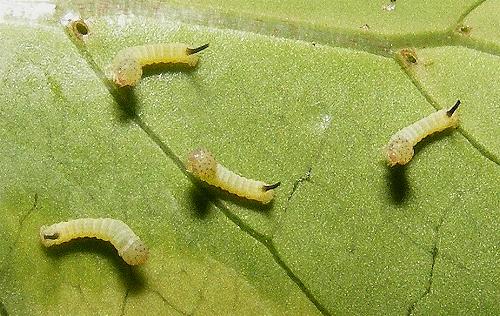
first instars
(Photo: courtesy of
Jenny Holmes, Victoria)

| Coprosma Hawk Moth (one synonym : Chaerocampa ignea Butler, 1875) MACROGLOSSINAE, SPHINGIDAE, BOMBYCOIDEA | (donherbisonevans@yahoo.com) and Stella Crossley |

first instars
(Photo: courtesy of
Jenny Holmes, Victoria)
Initially, these caterpillars are pale green. There is small harmless horn on the tail which is black at the base and has a pale tip. They feed openly by day on their foodplants, which include :
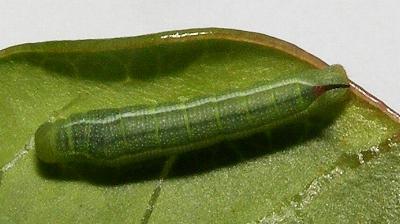
Despite being apparently nearly omnivorous, they seem disinclined to attack some plants, such as
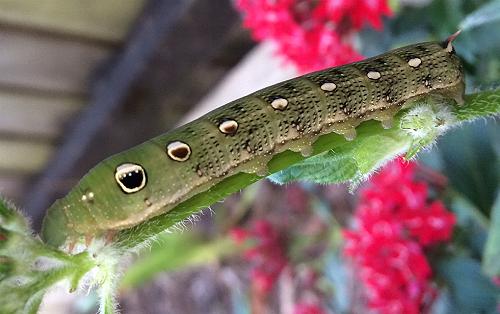
Later instars of the caterpillars develop pairs of subdorsal eyespots on the abdominal segments which degenerate along the body. The eyespots on the first segment have black centres with some white dots. The eyespots on the second segment have brown centres. The others are white bordered with black.
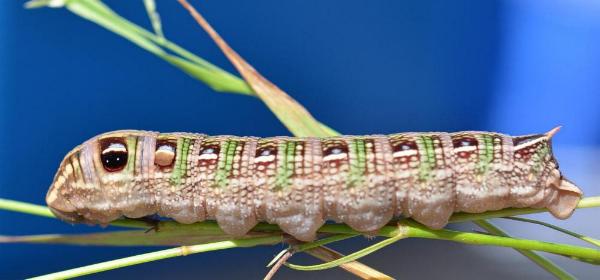
The head and thorax become narrower than the abdomen. The tail horn is shorter than that of caterpillars of most other SPHINGIDAE species.
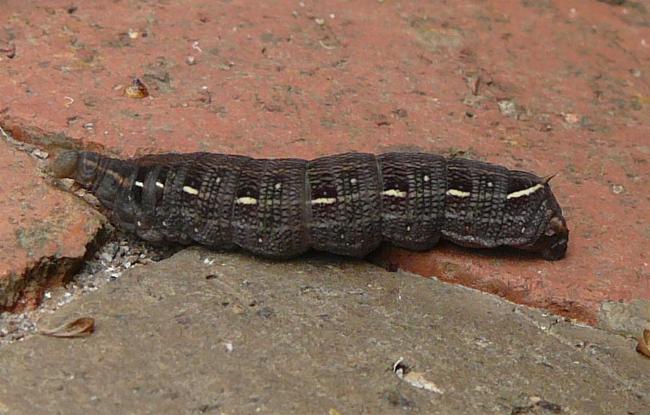
Mature Caterpillars usually become brown, with a pair of broken pale yellow subdorsal lines outlined in black along the body.
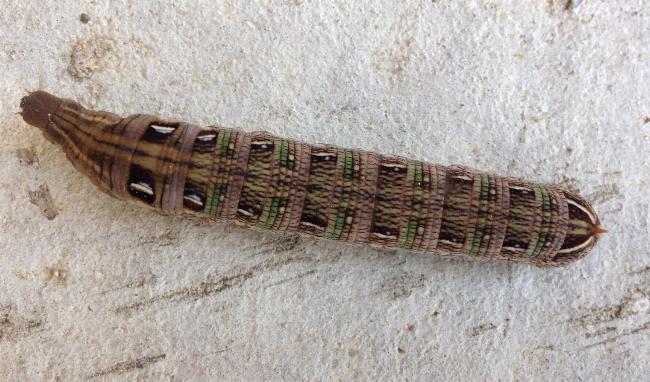
The caterpillars grow to a length of about 7 cms. When mature: it often goes walk-about, seeking somewhere nice to pupate.
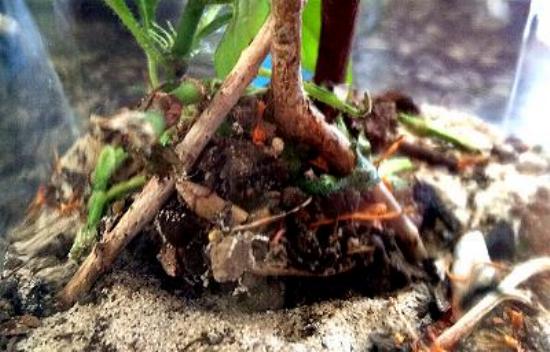
The caterpillar pupates in a loose cocoon which it covers with leaves and other debris.
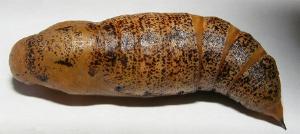
The pupa is brown with a rounded head and pointed tail. The pupa has a length of about 4 cms.
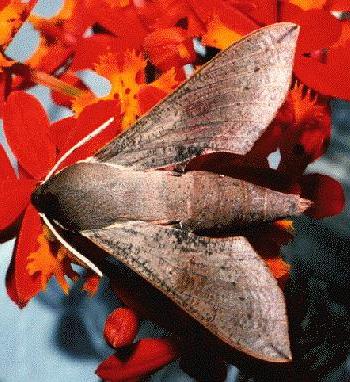
The moths have a wingspan of up to 7 cms. The body is brown and cigar-shaped. The forewings are brown, and the hind wings are red edged with black. The normal resting posture has the hind wings covered. They are revealed if the moth is disturbed, as it opens its wings for flight.

Underneath, the roles of the wings are reversed. The undersides of the forewings are red, and of the hindwings are brown.
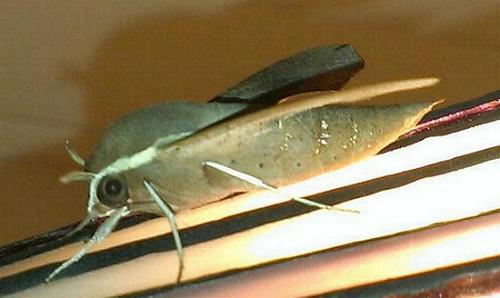
There is a white stripe runs around the top of the thorax and around under the head. There are also white spots on the sides of the abdomen.
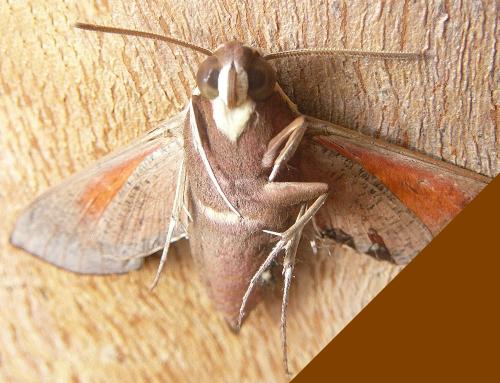
The eggs are pale green, spherical, with a diameter of about 1.5 mm. The eggs are laid in singly or in small groups on flower heads, young leaves, or stems, of a foodplant.
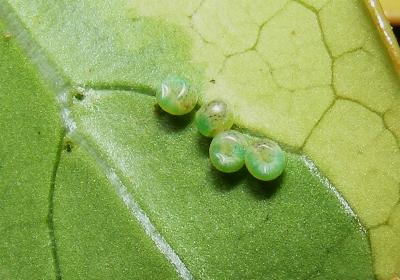
The moth achieved fame by embarrassing Yvonne Kenny while she was singing the Olympic Hymn in the closing ceremony of the 2000 Sydney Olympic Games, as it landed for a while on her bosom, although less observant announcers at the time erroneously blamed it on a Bogong Moth.
The species seems to be found over south-east Asia and the western Pacific, including
but more certainly over the whole of Australia, including

Further reading :
Jean-Baptiste Alphonse Dechauffour de Boisduval,
Faune Entomologique de L'Ocean Pacifique: Lépidoptères,
Voyage de Decouvertes de la Corvette l'Astrolabe,
Division 7, Part 1 (1832), p. 185, No. 3.
Ian F.B. Common,
Moths of Australia,
Melbourne University Press, 1990, pl. 16.10, pp. 414-415.
Pat and Mike Coupar,
Flying Colours,
New South Wales University Press, Sydney 1992, p. 87.
Peter B. McQuillan, Jan A. Forrest, David Keane, & Roger Grund,
Caterpillars, moths, and their plants of Southern Australia,
Butterfly Conservation South Australia Inc., Adelaide (2019), p. 102.
Peter Marriott,
Moths of Victoria - Part 1,
Silk Moths and Allies - BOMBYCOIDEA,
Entomological Society of Victoria, 2008, pp. 28-31.
Maxwell S. Moulds, James P. Tuttle and David A. Lane.
Hawkmoths of Australia,
Monographs on Australian Lepidoptera Series, Volume 13 (2020),
pp. 145-148, Plates 32, 77, 87.
Buck Richardson,
Tropical Queensland Wildlife from Dusk to Dawn Science and Art,
LeapFrogOz, Kuranda, 2015, p. 201.
 caterpillar |  butterflies |  Lepidoptera |  moths |  caterpillar |
(updated 7 February 2013, 26 October 2014, 22 February 2015, 13 December 2020)